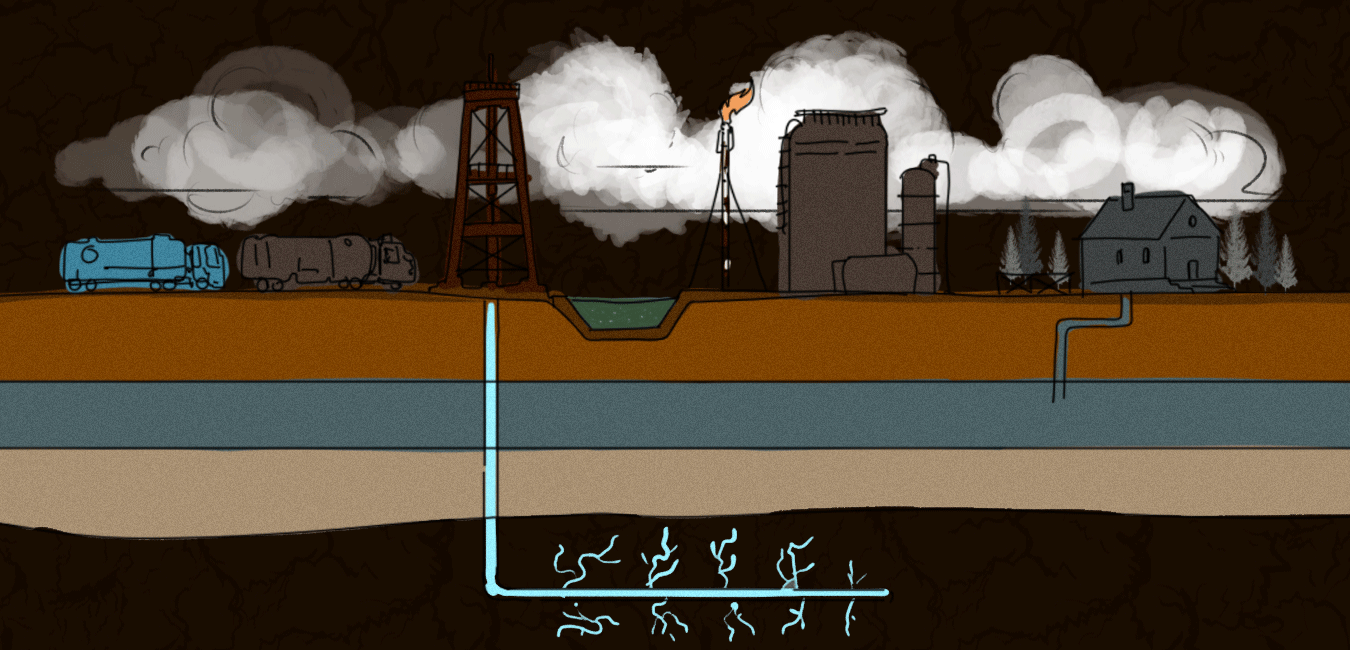


Over the past decade, there has been a notable uptick in large-scale “hydrofracking” endeavors across the Middle East and North African nations (MENA), inciting discontent among nearby communities residing near the oil and gas fields in arid regions.
Local inhabitants resist this process as it depletes their vital natural resources, directly endangering their homes and agriculture. Despite their opposition, certain Arab governments overlook this threat, driven by their ambition to exploit shale gas or compressed natural gas (tight gas) reservoirs, aiming for substantial financial gains from energy exports to Europe.
Hydraulic fracturing, or fracking, is a process that entails drilling wells to depths of thousands of feet below the surface, followed by horizontal drilling extending up to two miles. Subsequently, a high-pressure mixture comprising water, sand, and various chemicals, some of which possess toxic and carcinogenic properties, is injected into the wells. This procedure aims to induce fissures within the rock formations, facilitating the release of trapped oil and natural gas from the pores of the rocks. Countries like France, Germany, and Scotland have implemented bans on hydraulic fracturing due to its significant environmental ramifications. These include groundwater contamination, health hazards associated with the chemicals employed, and the potential for induced seismic activity resulting from the density and depth of drilling operations.

Hydraulic fracturing, also known as hydrofracturing, made its inaugural trial in the Hugoton gas field in Grant County, southwestern Kansas, USA, in 1947. Its maiden commercial venture proved successful in 1950. From 1950 to 2012, approximately 2.5 million hydraulic fracturing operations were conducted globally on oil and gas wells, with over a million operations specifically in the USA.
The sustained interest in employing hydraulic fracturing to extract gas in the MENA region arises from two principal drivers: the hastening energy transition and the demand for novel, cleaner iterations of conventional fossil fuels, alongside Europe’s imperative to broaden its gas supply base following the Russian incursion into Ukraine.
 Opportunities Amidst the European Crisis
Opportunities Amidst the European Crisis
Gas extraction allows an opportunity for the oil-producing nations in the MENA to uphold their export revenues. These countries capitalize on a transitional energy source by supplying natural gas, which is inherently less carbon-intensive than coal or oil.
The past two years have witnessed European policymakers crafting policies aimed at profoundly altering the sources from which countries fulfill their gas requirements, prompted by Russia’s incursion into Ukraine. Norway and the United States have emerged as principal gas suppliers for the EU: Norway fulfilled 30% of the Union’s gas needs in 2023, while US Liquefied Natural Gas (LNG) imports tripled compared to 2021, enabling the United States to now satisfy 50% of the European Union’s LNG demand.
These evolving dynamics present an opportunity for the MENA region, notably through infrastructure like the Medgaz pipeline, linking Algeria to Spain, and the TransMed pipeline, connecting Algeria to Italy via Tunisia. Algeria experienced a noteworthy uptick in natural gas production last year, rising from 132.7 billion cubic meters in 2022 to 136 billion cubic meters in 2023. Miloud Medjelled, the Director General of Exploration at the Algerian Ministry of Energy, anticipates a steady 1.4% annual growth in natural gas production until 2028.
Egypt has entered into a memorandum of understanding with the European Union and Israel to facilitate a “notable” surge in LNG exports to the European Union via the Egyptian LNG terminal in Beheira, situated on the Mediterranean coast. Officials indicated that the memorandum of understanding would require several years to be implemented. However, despite heightened domestic gas demand, Egypt achieved a 14% increase in LNG exports in 2022 to cater to European demand, as the Egyptian Petroleum Minister affirmed.
Since the onset of the European crisis, Algeria and Egypt have been actively developing several new gas fields in their respective countries. In Egypt, four notable fields include Narges, Harmattan Deep, North Borj, and Al-Tin. Similarly, Algeria is pursuing developments in fields such as Ahent, Isarin Complex, Al-Assal, and Iswan, as reported by the GlobalData database.
Source: Bruegel . Created with Datawrapper
Tunisia, another North African nation, aspires to explore and drill for hydrocarbons, including oil and natural gas. However, gas production in the country has been experiencing a decline over the past several years. For instance, from June 2023, production at the Hasdrubal field, Tunisia’s first exploration site and the largest field in the country, decreased by 4% since its discovery in 1975. Additionally, production at the southern commercial gas field reduced by 36%, while the Miskar field witnessed a 10% decline. In response to this trend, the state energy company, Tunisian Corporation for Petroleum Activities (ETAP), intends to attract more investments from international companies in the energy sector to revitalize production.
This investigation features how the European energy crisis has spurred governments in North Africa to resort to hydraulic fracturing to extract natural gas and trapped gas, notwithstanding warnings from experts and frontline communities regarding the potential threat to the fragile water supplies of the Sahara due to the water-intensive fracking process.
In this investigation, satellite imaging was employed to gather evidence regarding the utilization of hydraulic fracturing in the desert regions of three Arab countries: Tunisia, Algeria, and Egypt. The findings reveal that all three nations have established plans to escalate hydraulic fracturing activities to realize their gas production objectives.

Investigation: Eman Mounir and Nick Ferris
Illustrations: Ahmed Beka
Design and programming: Mustafa Othman
Additional support: Rehab Abdel Mohsen and Philippa Nuttall